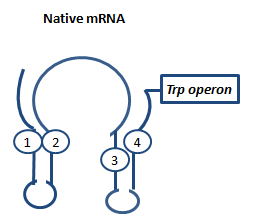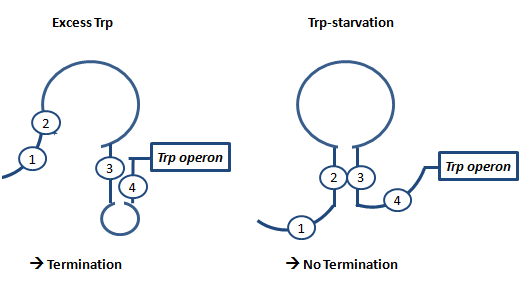Team:TU Munich/Glossary
From 2010.igem.org
(→Recognition Site (biLOGICS)) |
(→Specifity Site (bioLOGICS)) |
||
| Line 61: | Line 61: | ||
==Specifity Site (bioLOGICS)== | ==Specifity Site (bioLOGICS)== | ||
| - | The specifity site is the part of a [https://2010.igem.org/Team:TU_Munich/Glossary#Signal_.28bioLOGICS.29/ signal], that recognizes and provides the binding to a switch. Together with the [https://2010.igem.org/Team:TU_Munich/Glossary#Trigger_Unit_.28bioLOGICS.29/ trigger unit] which leads to antitermination, the signal can change the default state "off" of | + | The specifity site is the part of a [https://2010.igem.org/Team:TU_Munich/Glossary#Signal_.28bioLOGICS.29/ signal], that recognizes and provides the binding to a switch. Together with the [https://2010.igem.org/Team:TU_Munich/Glossary#Trigger_Unit_.28bioLOGICS.29/ trigger unit] which leads to antitermination, the signal can change the default state "off" of a switch to an "on". |
==Switch== | ==Switch== | ||
Revision as of 15:28, 24 October 2010
|
||||||||
|
|
AntiterminationAptamerAptamers in our case are defined as artificially designed single stranded nucleotides designated to specifically bind ligands. Large combinatorial libraries of RNA or DNA molecules are used to isolate and evolve aptamers which achieve surprisingly high affinity and specifity. Aptamers can be used for a broad range of applications: While in our case the malachitegreen-binding aptamer is only used for detection of RNA synthesis in response to an antitermination signal, other approaches use aptamers for regulating gene expression and - together with ribozymes - to design logical gates. By introducing the malachite-green binding aptamer to the Parts Registry we provide a nice tool to evaluate transcription both in vitro and in vivo. Malachite-green binding aptamers were already successfully used for cell cycle control in yeast and aptamers in general were lately tested in mammalian cells in vivo. ZITATE :) AttenuationAttenuation is a very smart way of gene regulation which is known from bacterial cells using two alternatice hairpin structures. For example, E. coli only needs very little amounts of Tryptophan in its metabolism, so the amino-acyl-Synthetase for Tryptophan is only rarely synthesized. So the trp-operon contains an attenuator before the actual enzymes. If Tryptophan is absent, the rare tRNA loaded with Tryptophan will not be available at once, so the Ribosome is stalled. Sterics do not allow the formation of a certain stemloop with the ribosome attached. If there is Tryptophan available and many tRNATrp float through the cell, the ribosome can just continue, a stem loop is formed and the ribosome falls off: The transcription of the following trp-operon is terminated.
E. coliBild von süßem Kuschelcoli iGEMI gonna end up in Massachusetts... Linker (modeling)Since Kinefold, the program of choice we used for modeling, can only calculate folding kinetics of individual RNA structures and not the interaction between two structures, which would our case, since it relies on a switch and a corresponding signal, a linker sequence is used to combine both sequences in one. The linker, shown as a row of X can be set to a specific length and does not interact. It mostly serves as a mere placeholder in this model, effects of the linker nevertheless influence the folding time. Since in reality the linker might be thought of as of infinite length, the results shown for the His-terminator in the modeling section considering varying linker lengths actually supports our model: long linkers level the influence of the signal length in time while the minimal free-energy is hardly influenced by the linker length. Logical circuitLogical operatorsRecognition Site (bioLOGICS)The recognition site is the part of a switch, which provides specifity towards the corresponding signal. While the switching element, fulfills the main duty of the switch, to change between an "on" and an "off" state and consists by definition of a terminator in the case of AND/OR switches and may be the same for a whole network, the recognition site provides the needed specifity for a switch to be only recognized by the corresponding signal and can consist of any sequence. RiboswitchWhile artificial aptamers are designed to specifally bind their ligands, riboswitches are developed by nature for gene regulation in prokaryotes, with some also found in eukaryotes. Riboswitches are part of mRNAs they control, located in the non-coding parts. They bind to specific metabolites and control gene expression by changing the three-dimensional RNA structures using effects like transcription elongation or translation initiation. Riboswitches typically consist of two parts, the aptamer domain and the expression platform. While the aptamer domain recognizes the metabolite specifically, the expression platforms allows transduction from metabolite binding to gene control by influencing the effciency of translation initiation, transcriptional elongation or stabilizing the mRNA in general. Signal (bioLOGICS)Signals are what make a switch a switch. Without the corresponding signal, the switches of our concept are terminators. The signal leading to antitermination and setting the default 0 in the case of a AND/OR switch to one. Each signal consists of a triggering unit and a specifity site. While the triggering unit provides the antitermination, the specifity site can be varied to bind to the recognition site of the switch. Specifity Site (bioLOGICS)The specifity site is the part of a signal, that recognizes and provides the binding to a switch. Together with the trigger unit which leads to antitermination, the signal can change the default state "off" of a switch to an "on". SwitchSynthetic BiologyTransistorTrigger Unit (bioLOGICS) |
|||||||
 "
"












